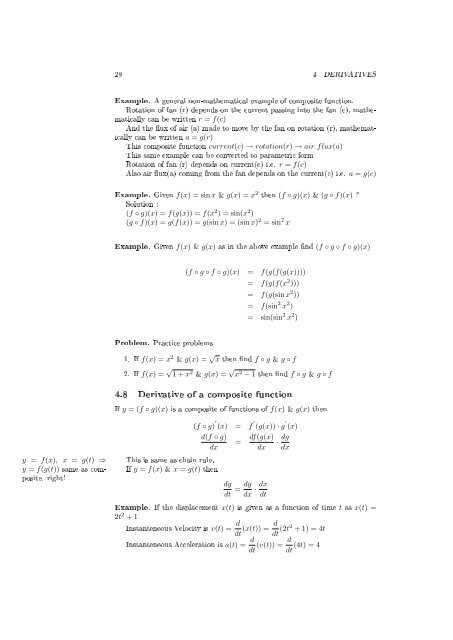Denition approach of learning new topics
You also want an ePaper? Increase the reach of your titles
YUMPU automatically turns print PDFs into web optimized ePapers that Google loves.
28 4 DERIVATIVES<br />
Example. A general non-mathematical example <strong>of</strong> composite function.<br />
Rotation <strong>of</strong> fan (r) depends on the current passing into the fan (c), mathematically<br />
can be written r = f(c)<br />
And the ux <strong>of</strong> air (a) made to move by the fan on rotation (r), mathematically<br />
can be written a = g(r)<br />
This composite function current(c) → rotation(r) → air flux(a)<br />
This same example can be converted to parametric form<br />
Rotation <strong>of</strong> fan (r) depends on current(c) i.e. r = f(c)<br />
Also air ux(a) coming from the fan depends on the current(c) i.e. a = g(c)<br />
Example. Given f(x) = sin x & g(x) = x 2 then (f ◦ g)(x) & (g ◦ f)(x) ?<br />
Solution :<br />
(f ◦ g)(x) = f(g(x)) = f(x 2 ) = sin(x 2 )<br />
(g ◦ f)(x) = g(f(x)) = g(sin x) = (sin x) 2 = sin 2 x<br />
Example. Given f(x) & g(x) as in the above example nd (f ◦ g ◦ f ◦ g)(x)<br />
(f ◦ g ◦ f ◦ g)(x) = f(g(f(g(x))))<br />
= f(g(f(x 2 )))<br />
= f(g(sin x 2 ))<br />
= f(sin 2 x 2 )<br />
= sin(sin 2 x 2 )<br />
Problem. Practice problems<br />
1. If f(x) = x 2 & g(x) = √ x then nd f ◦ g & g ◦ f<br />
2. If f(x) = √ 1 + x 2 & g(x) = √ x 2 − 1 then nd f ◦ g & g ◦ f<br />
4.8 Derivative <strong>of</strong> a composite function<br />
If y = (f ◦ g)(x) is a composite <strong>of</strong> functions <strong>of</strong> f(x) & g(x) then<br />
y = f(x), x = g(t) ⇒<br />
y = f(g(t)) same as composite.<br />
right!<br />
(f ◦ g) ′ (x) = f ′ (g(x)) · g ′ (x)<br />
d(f ◦ g)<br />
dx<br />
This is same as chain rule,<br />
If y = f(x) & x = g(t) then<br />
= df(g(x)<br />
dx<br />
dy<br />
dt = dy<br />
dx · dx<br />
dt<br />
· dg<br />
dx<br />
Example. If the displacement x(t) is given as a function <strong>of</strong> time t as x(t) =<br />
2t 2 + 1<br />
Instanteneous Velocity is v(t) = d dt (x(t)) = d dt (2t2 + 1) = 4t<br />
Instanteneous Acceleration is a(t) = d dt (v(t)) = d dt (4t) = 4



